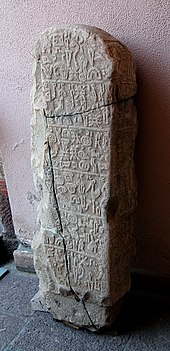Kayseri stele
The stele of Kayseri is a late Hittite monument from central Turkey with an inscription in Luwian hieroglyphics on all four sides. The stele is now in the Museum of Anatolian Civilizations in Ankara . It is in the second half of the 8th century BC. Dated and assigned to the kingdom of Tabal .
Research history
Yohanan Lewy was the first to see the stele in the courtyard of the house of Yahya Bey Zade Kadir in Kayseri in 1925 and reported on it in 1927 in the Archive for Orient Research . The Polish-US-American ancient orientalist Ignace Gelb received the information in 1935 that the stele had been in the house for a long time, but had been brought to Ankara in 1932 , where it was kept with other antiquities in the Augustus temple . He took it with the number 38 in his collection of Hittite Hieroglyphic Monuments . Bedřich Hrozný , 1936, Piero Meriggi 1957 and John David Hawkins 2000 in his Corpus of Hieroglyphic Luwian Inscriptions provided adaptations of the text .
description
The sandstone block with a round top has a height of 1.24 meters, a width of 43 and a thickness of 25 centimeters. A kind of peg has been preserved at the lower end, which indicates that the stele was set up in a base. It is described all around with a six-line inscription in high relief with a line height of 16 centimeters. The text begins in the upper right corner of the front, runs clockwise around the stele to continue bustrophedon . The end is again in the lower right corner of the front. The front was later smoothed in parts, the text was covered with a large Maltese cross with a base and several small crosses. The sides are badly crushed, so that the inscription can only be read very fragmentarily. It begins with a dedication for the god, whereby the god is not mentioned and the name of the dedicator including his descent is illegible. He describes himself as the servant of King Wasusarma . An unusually long formula for a curse follows. The text ends with the deeds of Tuwati. A Tuwati (s) is known as the father and predecessor of Wasusarma and is mentioned in the rock inscription of Topada . Since the reign of Wasusarma is known, the stele can be dated between 740 and 730 BC. To be dated.
literature
- Ignace Yellow: Hittite Hieroglyphic Monuments (= Oriental Institute Publications . Volume 45). The University of Chicago Press, Chicago 1939, p. 34 pls. LVI-LVIII.
- John David Hawkins: Corpus of hieroglyphic Luwian inscriptions . Vol 1. Inscriptions of the Iron Age . Part 1: Introduction, Karatepe, Karkamiš, Tell Ahmar, Maraş, Malatya, Commagene. de Gruyter, Berlin 2000, ISBN 3-11-010864-X , pp. 472–475, plates 262–263.


